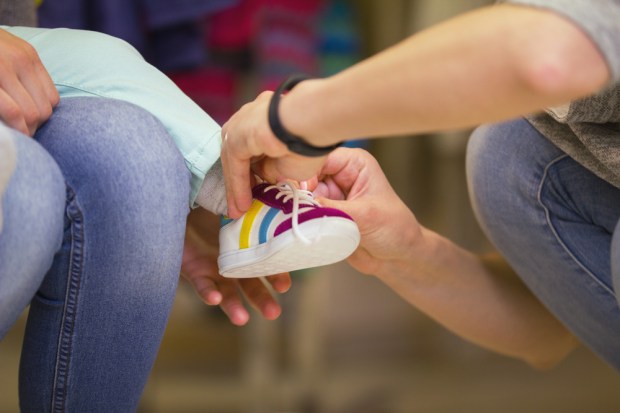A New Take On Shoes, From A Very New Merchant

While parenting books cover a wide variety of topics big and small, very few adults go into the adventure of raising children knowing exactly how much time, effort and energy they will spend trying to keep their children in properly fitting shoes – nor do they know how likely they are to fail abjectly in their efforts.
As of 2009, Swiss researchers presented findings to the American Academy of Orthopaedic Surgeons that indicated children are usually wearing the wrong-sized shoes. Whether indoor or outdoor, kids are wearing footwear that just doesn’t fit right, despite their parents’ best efforts. Usually the problem is that the shoes are too small – that was the case for 53 percent of outdoor shoes, while another 13 percent were too large. The problem actually gets worse inside, where apparently lighter use makes for higher chances of wearing the wrong size: 89 percent of children studied were wearing footwear that was too small.
It’s not that parents don’t want to buy their children well-fitting shoes. On average, American parents buy their children 2.5 pairs of shoes per year – and one would assume their preference would be to purchase those that fit properly.
But buying children’s shoes is more challenging than one might assume, because children’s feet are constantly growing, but not consistently growing. Children’s shoes sizes increase by about a half size every six months on average, until they turn 12, when their foot is at 90 percent of its lifetime size. But that growth, according to pediatricians, is “spurty” – which means parents who wake up one morning to find their child’s foot has apparently grown a size overnight aren’t entirely imagining things.
And shoe shopping with children in tow – particularly young children – is not anyone’s favorite commerce experience. Buying shoes online has a great deal of appeal for parents, because having children in a shoe store presents a laundry list of parent woes – but it’s not easy to buy online for a person whose foot size is always in flux. While shoes purchased in stores for children have an 8 percent return rate, shoes purchased online for children have a 20 percent to 30 percent return rate.
Enter Jenzy, the eCommerce brainchild of two Philadelphia-based entrepreneurs who, like most of the people we talk to, started out trying to solve a problem they first encountered themselves in real life: taking one’s young nieces shoe shopping.
Eve Ackerley and Carolyn Horner didn’t start out thinking about sizing children’s shoes – the initial design for their app was focused around adult female consumers. One bad shoe shopping trip later, and Horner realized that adult women, by and large, know their shoe size. That size can vary by vagaries of sizing conventions, brands and shoe styles – but most adults go into shopping with a baseline idea of the size of their foot.
Parents, they realized, did not have that experience – which meant there was an opportunity to solve an actual problem.
“So often, apps get built and they’re not really solving a problem, and we really, really wanted to solve a problem with Jenzy,” Horner said.
To solve that problem, the co-founders spent a year beta-testing the Jenzy app with a control group of 300 moms who helped them iterate the most user-friendly experience possible – an experience that will sound quite familiar to anyone who has ever used Warby Parker. The app measures foot size by using a smartphone’s camera to compare the child’s foot with a standard credit card.
It was also during the testing phase that Jenzy’s founders realized consumers weren’t just looking for a place to size their children’s feet – they also wanted to be able to buy shoes while they were there (neither Amazon nor Zappos have sizing capabilities). And so, users can not only learn their child’s shoe size from the app, they can also shop a curated selection of children’s shoes tailored to match the customer’s needs.
Jenzy is in its very, very earliest days, with about 250 downloads of its sizing tool and about 20 purchases from its shoe marketplace. As the business is very new, it is in many ways subject to lots of change and flux. They’ve already changed their target audience twice – and as they add users to the platform, they are aware there is still probably a lot to learn about consumers and their preferences, though they are confident they are starting in the right place.
“We first started with a focus on older kids, and were looking to shoe children of 13 or 14 years old,” Horner said. “We cut back so now we are only working with kids zero to six, and to date we are offering them about 55 shoes in our inventory. But we are confident in how to fit them and confident that they’re good kids’ shoes, too.”
Back to school is around the corner, followed by the Christmas season of kids’ shoes. Parents, they are wagering, will want the convenience and comfort of being able to buy a correctly sized sneaker without having to take their elementary-age children shoe shopping.
Jenzy’s goal is to have 5,000 app downloads by the end of back-to-school season.
We’ll keep you posted on the progress.
